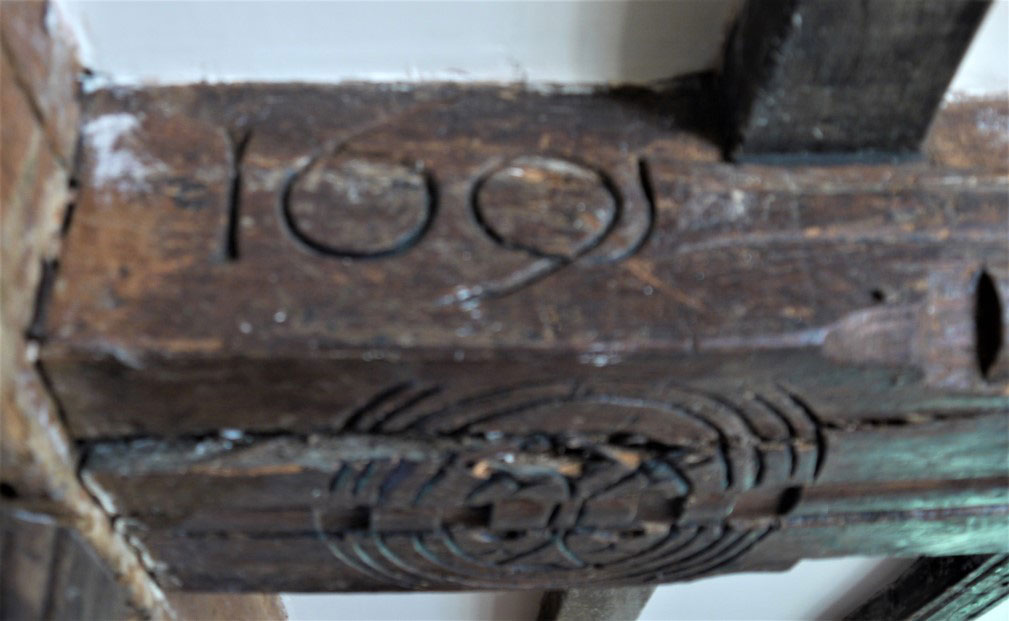Kindly note this site is a private house and not open to visitors.
Old Orchard, Spirthill, is a Grade II listed building described as a late 17th century timber frame and painted brick dwelling with thatched roof and north end stack. It incorporates the end wall of an earlier, possibly 16th century building. It has a 20th century south end extension.
One of the first known visual representations of Spirthill and Old Orchard, is the 1773 Andrew's & Dury's Map of Wiltshire. The map shows the hamlet with approximately 15 farm buildings and cottages, including a building depicted on the site of Old Orchard. The house belonged to the Bowood Estate as a freehold property and was probably rented out to agricultural labourers up until the 1920's when the house was sold off, along with Spirthill Farm.
Some of the earliest documents relating to Spirthill are the court books of the Manor of Bremhill, from the papers of the Bowood Estate. The descriptions in these records make it difficult to pin point the exact accommodation. One early record from a Court Baron held in 1745 mentions “To this Court came Hannah Hale Widow and Relict of John Hale her late Husband deceased and claimed to hold for the term of her widowhood -one messuage (house) and two yard lands with the appurtenances in the Tything of Spirthill”
Before the Victorians started the census, another source of reference are the rate books for Bremhill Parish. In 1817 there were 17 rateable properties in Spirthill. Two properties identified as ‘houses’, presumably indicating that they were simply cottages rather than properties with accompanying land. One of these houses was occupied by George Lewis and he was still resident in the cottage in 1834 when Spirthill had grown to twenty-one rateable properties of which four were “houses”. Basket maker, George Haddrell, occupied one of these houses, later described on the 1861 census return as Spirthill Cottage.
Whilst it is not possible to say for sure which families occupied Old Orchard during the census of the first decades of the Victorian period, much can be learned about the sort of family that would have called it home. Of the 22 Spirthill households identified in the 1841 census, just four heads of households were identified as farmers, with 15 listed as agricultural labourers. The remaining three were a mason, a basket maker and a widow.
Life for a Wiltshire agricultural labourer was by no means comfortable. They relied almost entirely on farm wages to sustain their families, and by the end of the 18th century, wages in Wiltshire were some of the lowest in the country. Food was the highest cost to be met, with bread alone counting for 60% of a household’s expenditure of in the 1790's. Labourer accom-modation mostly consisted of small cottages, with one room upstairs and one downstairs, perhaps with the space below the roof accessed via a ladder. The front door would have opened directly into the living room and some cottages may have had additional outbuildings that served as kitchen/scullery or a washing area. Furniture was minimal and was either inherited from family or homemade.
In 1915, under Lloyd George’s government, the Valuation Office was created and Old Orchard was assigned the number 185 for valuation purposes. The Field Book for Lord Landsdowne (the 5th Marquess) shows that number 185 was rented to Amelia Salter and describes the property as a cottage built of brick, half timber, and thatched, with a garden. At this time, it had a kitchen, pantry, back kitchen, two bedrooms, a privy and a pigsty. The house was in poor repair and was supplied with water from a well. The well still remains in our back garden.
The 1920 electoral register shows James Matthews, agricultural labourer as residing at number 25, Old Orchard. He and his wife Jane, along with his son Herbert and his wife Mabel, continue to live at the property. It was sold in this time by Lord Lansdowne to Arthur Pocock along with Spirthill Farm. Herbert Matthews is listed in several electoral registers of the time as a haulier. His grandson, Bryan Matthews, still lives in Spirthill, and he too is a haulier.
The cottage’s first transformation began in 1935, when Arthur Pocock submitted plans which proposed changes as “a small addition to an existing cottage, thatched roof, brick stuccoed walls.”
In 1943 the farm and cottage were sold to Hubert Potter. There were no electoral roles during the war and the one in 1945 indicates that the tenants were Edward and Fanny Smart at the time. Edward’s father Elijah Smart had been an agricultural labourer in Spirthill.
From 1951 - 1962, the tenants were Francis Clark and wife Phyllis. In 1963, James Mowry, of the Teachers College at Columbia University in New York purchased the property. There are no signs that he actually lived in the house and records show that John and Eileen Cook lived here. In 1969 the property is purchased and lived in by Stella Bridge. The house is then sold twice more before the current owners, Graham and Sarah Jones purchased this delightful cottage in 2006.
Historic England Listing
OLD ORCHARD
- Heritage Category: Listed Building
- Grade: II
- List Entry Number: 1283453
- View Historic England Listing




